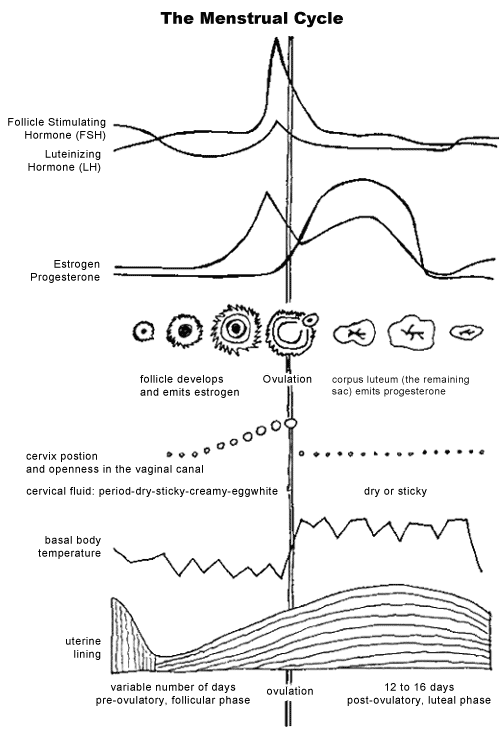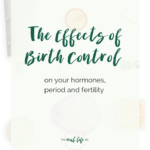I realize that talking about birth control, periods and things related to a woman’s reproductive system is not only sensitive, but controversial at times. I write these posts because I wish I would have been more educated on my own body when I was in my teens and early twenties so I could make the best decision that was best for me. I went almost 10 years thinking not having a period unless I was taking hormonal birth control was “just fine” and in retrospect…it was anything but fine.
These posts are not meant to be a sociopolitical or religious conversation, or a position on women’s rights or feminism, nor am I trying to tell you what to do with your own reproductive health. My goal is to educate. Because I believe in informed consent and your right to know all your options so you can make a decision that is right for YOU.
This post on FAM (Fertility Awareness Methods) is for your knowledge and education. For a short summary on other methods of contraception (birth control pills, patches, rings, IUDs etc) read here. By reading this post I hope you walk away more knowledgeable about your body, more empowered when it comes to your reproductive health and simply a little more fascinated by the female body…because it is so complex, yet impressive and awesome. 🙂

Birth control pills, patches and rings, IUDs, shots and implants are 99% effective (give or take a few tenths of a percent) when used perfectly. Male condom use is 98% effective when used perfectly and FAM is 95-97% effective when used perfectly. Of course, there is always human error, so the more room for error, the less effective these methods become. The efficacy of birth control pills, patches and rings decreases to around 92% when you account for this error…something we call “actual use.” The Depo Provera shot and IUDs have minimal error involved, therefore the “actual use” and perfect use efficacy are relatively the same. Male condom use efficacy drops to 85% when accounting for human error and FAM drops to 75% when accounting for error. FAM involves more factors and human interpretation which can create more room for error. So while I think it’s really important to know that, I think it’s also important to know that the more you learn your body and use FAM accurately, the closer the efficacy of this method is to that 95-97% range.
FAM isn’t right for every woman, but it is an option for every woman. My hope is simply to provide information. Regardless of whether you’re married or single or a mom or never plan on becoming pregnant, FAM can be a liberating way for us women to learn our bodies and menstrual cycles, enabling us to work with our bodies instead of against them.
Okay, so…
WHAT EXACTLY IS FAM?
In essence, FAM is a method for tracking your menstrual cycle so you know exactly when you’re ovulating….aka when you’re ovaries release an egg each month.
The days leading up to ovulation are considered “fertile” days and these are the days you’re most likely to get pregnant. If you don’t want to get pregnant you can either 1) not have sex or 2) use a barrier method, like condoms. There are a handful of different FAMs that can help you in tracking ovulation. You don’t have to use all of them, you can use just 1 or a couple, but the more you use the better picture you will have of your fertility so you can predict ovulation. To increase efficacy, I high recommend tracking in an app with both temperature, symptoms and cervical mucus monitoring. Natural Cycles is an app I like. There are many to pick from.
Also important, keep in mind that FAM does not protect against STIs (sexually transmitted infections) and neither do hormonal forms of birth control nor the copper IUD. Use condoms (or of course, don’t have sex) if you want protection against STIs.
TYPES OF FERTILITY MONITORING
- temperature – this involves taking your temperature with a basal thermometer right when you wake up, before you even step out of bed in the morning
- cervical mucus monitoring – this is where you get intimate with your vagina and check your cervical mucus aka your vaginal discharge every day
- calendar charting – you chart your menstrual cycle on a calendar…but now that it’s 2017, by calendar I mean an app (here is a roundup of several apps to choose from based on your individual needs) or stick with good old fashion paper
In order to use FAM, you’ve got to know about your menstrual cycle. This could be something you know, but if you don’t…here it is in a nutshell. In order to get pregnant a sperm has to fertilize an egg. There are days when this is possible and those days are called your fertile days. Each month your ovary releases an egg into your fallopian tube, known as ovulation, and that egg hangs out there for 12-24 hours. Sperm can hang out in the uterus/fallopian tube for up to five (yes five!) days after you have sex. And if the sperm fertilizes the egg…that egg makes its way into your uterus and attaches to the uterine wall, and thus pregnancy. No sperm to fertilize the egg and you end up getting your period.
Since an egg sticks around for about a day after ovulation and sperm hang around for up to five days after sex, that means you’re potentially fertile for 7-9ish days per menstrual cycle (the five days before you ovulate, the day you do ovulate, and possibly the day after ovulation.
TEMPERATURE METHOD
For this, you’ll need a basal thermometer since changes in temperature are very subtle throughout your cycle. Your body temp is lower in the first part of your cycle (the follicular phase) and then you see a slight rise when you ovulate. Typical temps for most women are between 96-98 degrees F and then temperature goes up a touch to 97-99 degrees F when you’re ovulating — a small amount so you need a precise thermometer! After ovulation your temp stays higher until your period. If it continues to stay high past a normal luteal phase length (about 16ish days) then you could be pregnant. Progesterone is responsible for this thermal shift.
For this method you have to take your temp at the same time every day before you do anything. Before you even talk or check your phone, take your temp. Then record it in your app. Over time you’ll begin to see a pattern within your cycle (because the pattern can change from cycle to cycle) Taking your temperature takes like 60 seconds. Also make a note of other factors like crappy sleep, being sick, drinking the night before, stress etc so you know if abnormal rises in temperature are related to other things.
When you see that rise in temperature, that means ovulation has already occurred – typically the day before. So I would not recommend using temperature as your sole indicator of fertility or not — if you want until your temp rises to avoid sex, you will have already ovulated and therefore, pregnancy could have very much occurred already. Use temp to help you interpret other subjective signs like cervical mucus and cervical position. Keep in mind that you should track your temp for 3 solid months before relying on this method.
CERVICAL MUCUS MONITORING
I find this method to be the most fascinating. Vaginal discharge is thought of as gross, weird, awkward to talk about…. but it can tell you so much about your menstrual cycle. So get cozy.
The hormones that control your menstrual cycle (primarily estrogen) also cause your cervix to produce mucus which then exits your vagina as discharge. This method involves checking your mucus daily and adding it to your app (or paper charting it if you want to be old school) The changes in your mucus let you know where you’re at in your cycle.
So how do you check your cervical mucus? Well, you feel (yes feel) and look at your discharge every day. After your period stops completely is when you start tracking. If you don’t care to actually touch your discharge, then simply look at the color and texture of the discharge in your underwear. If you really want to get up close and personal with your discharge, you can either wipe before you go pee and then check the color and texture on the toiler paper (use white tp) or you can place your clean fingers into your vaginal opening and check the color/texture of the mucus on your fingers. Any of these ways works.
A few things to note: record everything you see and feel with your mucus and record it in your app or chart. Before relying on this method, chart your mucus for at least one entire cycle. (I prefer 2-3 cycles so you can get the hang of it)
So what should your cervical mucus feel like and what can your mucus tell you?
- When you’re on your period, the blood flow makes it impossible to notice your mucus. Sperm live for up to five days so if you have sex towards the end of your period and then ovulate on the early side, those sperm could potentially live long enough for you to conceive 5 days later. So all that to say, it’s not likely you’d be fertile during your period, but it’s not impossible.
- When your period ends, there are typically a few days after where you won’t notice any discharge and these are called dry days aka non fertile days.
- As an egg begins to ripen, your body produces more mucus as ovulation gets closer. You’ll notice this mucus is yellow, white or cloudy in color and it feels sticky. Almost tacky. Kind of like drying lotion. Then it transitions to a creamy, milky yellow or white color that looks like hand lotion. You’re sightly fertile on these days.
- Right before ovulation is when you’ll notice the most mucus, it’s clear in color and slippery, like a raw egg white consistency that can be stretched between your fingers. These are highly fertile days when you’re most likely to get pregnant.
- After about 3-4 “egg white” days then you’ll suddenly notice less mucus that becomes that yellow, cloudy color and sticky again, followed by 3-4 more dry days with no discharge. These DRY days are again, non fertile days. Then you get your period at the end of these days and the cycle starts again

THE KEY with CMM is that no cycle is the same. Your mucus varies from day to day depending on several factors. For example, if you’re highly stressed or maybe you ran a half marathon…you might find you ovulate later that month. If you’re on vacation or maybe you take a break from formal exercise…you might ovulate sooner. You’ll see a later or earlier temperature shift as well if you’re monitoring temp.
Also keep in mind that breastfeeding, the morning after pill or other recent birth control, douching, STIs and vaginal infections can cause changes in your mucus and make CMM difficult to monitor.
TAKEAWAY POINT: if you see mucus, you’re possibly fertile and need to either use a barrier method or not have sex if you don’t plan on getting pregnant. If you want to conceive, then have at it!
THE CALENDAR METHOD
I’m not going to post much about this method here, since I actually find it to involve too much math (I need simple stuff) and not very accurate. The calendar method can only predict days that are mostly likely fertile vs non fertile. Unlike CMM and taking your temperature which tells you exactly what is going on with your body that particular cycle, the calendar method is a predictability method based on previous cycles. Your life changes from month to month (stress, physical activity, eating patterns, sleep, sickness etc) so unless all the variables are the same (which is nearly impossible) the calendar method alone is isn’t very reliable. It can help you predict when to look for changes in cervical mucus and your temperature though if you find that helpful!
IN ADDITION to tracking your cervical mucus and temperature, I recommend noting things like PMS symptoms, breast tenderness, exercise, sleep, swings in your food intake etc so you have a better picture of how your reproductive parts are working.
Some of you might be reading this thinking, what in the world Robyn?? This is so gross. I know it might seem that way because we are taught this stuff is shameful and women aren’t educated enough on how their bodies work. But I think having knowledge about how your body works isn’t gross, but rather empowering. And it’s your right.

I know and acknowledge that 1) FAM is not right for every woman and 2) there are other non hormonal methods that might be a better option for some women (condoms, copper IUD, etc) and 3) some women feel best with hormonal birth control.
If you want to get to know your body better so you feel more confident knowing what is abnormal vs normal for your body, FAM is a tool out there to connect you with your body and allow you to be more in tune with what’s happening from month to month. For some women, this is just what they need. For others, not so much.
I hope this is helpful as you decide what’s best for your health!
















Thank you for writing this all out. I’ve tried reading about this before but end up getting confused, but this is so clear. I’ve always been intrigued with this idea, but too terrified of becoming pregnant to try it! Condoms are the best thing for us right now, but I definitely see a time in our future where I will want to try this.
This is so interesting thank you!
It’s only now that I have a copper IUD that I have really been noticed all this about my body.
I was wondering if it’s possible for some women to have a tiny bit of blood in their mucus while they are ovulating? It happens to me occasionally for maybe 1-2 days. Nothing like a period just a hint of red in the mucus close to ovulation. I have had tests and nothing test came back so just wondering.
Hi Annie! Just wanted to tell you that I had a copper IUD for a while and I almost always had a slight amount of blood around the time I ovulated. I also would feel a little crampy. Hope that helps you feel a little at ease! 🙂
Hi katie!
Thank you for your input, it is appreciated.
I was wondering if it had anything to do with the IUD as I’d never had that on the pill.
I also feel a little crampy around that time too so its nice to know it happens to other people 🙂
this is not uncommon annie – when the follicle ruptures to release an egg it can cause a trace of blood. But double check with your doc!
This post is so interesting to me & I learned so much from it, so thank you for writing this Robyn. I honestly had no knowledge of this beforehand & it’s obviously something SUPER important to know about. I have had issues with getting my period naturally, so these posts have made me really stop & realize that having a fake period each month from birth control isn’t normal. Since these posts, I have gotten off & am trying to figure out and track what is going on with my body (also going back to my OBGYN) but if it weren’t for you & these posts, I wouldn’t have stopped to think that being relying on birth control to get a period is abnormal. I want to have kids in a few years & I need to get this figured out now. Our bodies are so smart & I think FAM is awesome. THANK YOU!!
Lindsay! I’m so glad you have found the posts helpful! Thinking of you on this journey!
Thanks for explaining a topic that often gets overlooked in the area of female reproductive health. As a fellow nurse and DNP student doing my research and project work in reproductive health services, I appreciate more attention being brought to this topic, while taught in conjunction to the full spectrum of birth control options. One thing that you missed pointing out that I think is super important is that FAM offers no STI protection. Yes, most women who use this method are probably married or in a long-term relationship and not concerned about STIs, but as a health care provider I think its important to cover everything, including STI protection, when discussing birth control options.
great point! I will edit the post to ensure I include that – I tried to go over it to make sure nothing was missing but missed this. Thank you for pointing that out Sarah!
I am SO thankful you actually talk about this stuff! I’ve struggled over the last year with some vaginal issues and not one of my OBGYNs has ever mentioned the FAM methods when I’ve brought up birth control. It wasn’t until I ended up going to pelvic floor physical therapy that it was suggested. Women in general should be educated on this and I’m so glad you take the time to discuss it!
thanks for reading rachel!
Thank you so much for this! I’ve been wanting learn about this for some time now. It’s great to know there are different effective methods of preventing pregnancy besides birth control. Please continue to use this blog as a way to educate your readers in a way their providers might not be. Your amazing Robyn, thank you.
Hey Robyn, I hope this isnt tmi but i was wondering if its normal to get discharge everyday? I do and Im not sure if that is healthy or not.
I would encourage you to get checked out by your primary care doc (if they do women’s health) or GYN….you should have some dry days usually but I dont’ know much about your situation so don’t want to give false information!
I think you are AWESOME for writing such an educational post. I honestly feel like Sex Ed classes would benefit from printing out this post to hand out to young women! And you are so right. We often are never taught or told any of this. I know you said you didn’t want to get political, but I could go on all day about how I believe this hesitancy to teach women about their bodies is just another way to make us feel ashamed of them and as if there’s something we should hide. Maybe if more information was out there like this, then it wouldn’t be so taboo. Thank you!
In my opinion I do not think that the reason FAM is talked about less than other birth control methods is because anyone is trying to shame women or their bodies. I guess I’m not feminist enough, but I don’t think all men are out to get us…..
I think it is more likely because medicine is very focused on treating with pharmaceuticals or a different type of “fix” rather than a more natural method. This in combination with the fact that FAM is a less reliable method than other options.
(although I definitely wish that adolescents were taught more about their bodies, I am kind of glad that reinforcing that there really are only a few days a month a woman can get pregnant is not common. Think of the number of teens that would think that they were safe from getting pregnant, when they are likely not taking the time to truly track temps and mucous, as well as the fact that periods are not always regular in the teenage years)
Just my thoughts.
Hi Paige! I hear you in that conventional medicine is overall (but not always) quick to prescribe medications than do patient education because 1) there is no money in patient education and 2) insurance hates and reimburse for that and 3) its’ harder to learn a method than take a pill and takes more effort from a provider (and they are worked hard as it is) it’s unfortunate healthcare is set up this way but know that I can agree with your point here.
I would never recommend FAM for teenagers (on a rare event) because they are not in the mindset (often) to prioritize and put effort into family planning. Teaching condom use and the importance of that (for pregnancy and STI prevention) is a better use of the scarce time we do have. BUT teaching women about their bodies vs using hormonal birth control for issues other than contraception is a whole different ball game.
I appreciate your thoughts and this conversation! Thank you!
I’m glad you’re enjoying them Amber! I’m not sure if it’s a shame issue or a time issue or perhaps we haven’t figured out the appropriate space to educate (school, home or at the doctor?) but hopefully we will get better at all this!
This was very very well explained. Ever since I recovered from amenorrhea I’ve been learning a lot about FAM. Only a few people teach this and I’m so glad you’re spreading this kind of info out there as well. Thank you
Much appreciation for this post. You broke it down so well!
I know some people think this is “gross” but we need to get rid of that stigma because understanding our bodies is so important for our overall health. Female hormones are so fascinating and I always enjoy when you give a little more insight into them. I recently got my period back after three years without it due to an ED. I am wondering if this kind of monitoring can be used when dealing with amenorrhea. My period has only come back once and I am waiting to see if it will return again after four weeks. In the meantime I might try using this method to see if there are any changes in cervical mucus and m body temperature. I am curious as to what is going on inside my body and if I am ovulating despite not having a period.
Anyway TMI? I hope not! Thanks again 🙂
I agree that we shouldn’t be grossed out too, so the more we talk about it the less that will be the case I hope!
Yes it can be a good way to monitor what your body is up to …but until you get a “regular” cycle I wouldn’t rely on it for contraception!
Never TMI 🙂
Thank you for these posts!! Love the graphics you made, too. My husband and I were doing paper charting but then it just got too overwhelming. In this post you mentioned that no two cycles are the same, but I learned that they should be the same (or at least within a small range… like always around 28 days or something like that). Is that true? Thanks Robyn!
A cycle that is relatively the same (give or take a few days) is a good thing, but our lives change so basing your fertility on the month prior is not a good thing since things could change from month to month (ex: more stress and you might ovulate later in the month) Plus 28 days is what the textbooks say but 25-35 days is “normal” Every woman is different!
I LOVE these posts!! I think women are very under-educated about the intricacies of their body and reproductive health, so it’s refreshing to finally see someone addressing this! Thank you for sharing 🙂
While this post isn’t 100% relevant to my life (I’m neither married nor sexually active), I always find your posts about women’s health to be fascinating! I appreciate that you share the knowledge you have, and I hope it works toward making women feel less grossed out by their bodies. I used to be extremely grossed out by this type of thing, but about five years ago I started using a menstrual cup (after having spent about 6 months prior reading about and being grossed out by them), and that has changed everything for me.
I had a patient last week say the Diva Cup CHANGED HER LIFE because she has a heavy flow – so you’re not alone in loving it and being way more comfortable with your body. So happy for you and thanks for sharing Ashley!
Neat post! I used the FAM while trying to get pregnant and it was really neat to see and track all the changes in my body. Now that my little one is here and I’m not trying to conceive I feel more comfortable with a hormonal IUD than FAM. I would be devastated right now if I became pregnant so I really depend on that 99% effectiveness that my IUD offers. Plus with a little one it’s hard enough to find time to have sex … so if the opportunity came up and I had to think about if I was fertile or not or whether we needed a condom … just one less thing I need to think about!
Thank you for sharing what works for you Andrea – different things work for different women and the most important is that it is best for YOU! haha great point about less to think about when the occasion does arise 🙂
Before I got married I read Taking Charge of Your Fertility and was so bummed that I hadn’t read it earlier! It just helped me understand my body so much better! So glad you’re sharing such helpful information:)
great book, agreed!
Thanks for educating us. I appreciate you wanting women to be informed about their bodies Our bodies are SO amazing! Also, I love all of the charts related to a menstrual cycle is in one graphic.
I loooove this! I’m not sexually active, but I love the female reproductive system and hormones! So complex and amazing. This post is super informative and empowering, and I love how you talk about our bodies with excitement and pride..as it should be! These things shouldn’t be embarrassing to talk about; us women are incredible 🙂 thanks as always!
<3
Thank you for this post, Robyn! Because of your posts on hormones and periods, I have decided to go off the pill and try non-hormonal methods. I am on my first month without the pill and already feel so empowered. I would love to do FAM, but my husband does not want to risk anything right now. We are trying a diaphragm, but I am going to also try the methods you mentioned above so I can understand my body better. The female body is amazing! Thank you for helping me understand my body better!
I am glad you feel empowered! And FAM is not for everyone, but there are other options that don’t involve hormones and I hope you guys find helpful!
This is such a helpful post, and thank you so much for talking about this! I admit I find FAM a tad daunting. I mean it does require more work than some other methods, but I am also very against hormonal contraception, so I think this might just be worth trying for me.
It is a learning curve for sure – once you get the hang though it’s gets more natural.
Thanks for this informative post!!! I have a semi-unrelated (but equally TMI) question— often, whether or not I notice cervical mucus, I experience mucus in my stool. I know you’re not a GI doctor, but do you know what could be causing that/ if that is normal? Thanks so much!
no such thing as TMI 🙂
mucus in your stool isn’t usually normal so I would ask your GI doc about that!
Great post! I’m echoing the other women, but this is definitely an under-discussed topic. I think something else to mention is that’s it’s also important to find a women’s health provider who understands and can help interpret a chart to best address any abnormalities (like the comment about mucous every day), specifically a Napro Technology trained OB. Thankfully there’s an awesome OB close to us in Ft Wayne, IN who understands the different signs of a women’s cycle, and is able to diagnose & treat in a respectable and ethical way. Thanks again for posting! Apologies for my lengthy comment ????
Agreed with your comment on informed providers Ellen! I am from IN so this is great that there is one in Ft. Wayne – I would love her name if you email me 🙂
I just loved this post! I was on bc for years previously to help regulate hormones d/t amenorrhea from being underweight. I never had an issue, but once I started recovering weight back after years of orthorexia, I finally got my period back and it was like…”Yes! My body is capable of this amazing thing on its own!” Also, I just got married and tried bc again, but had some uncomfortable side effects this go-around and was looking into FAMs, but was scared about the higher chance of getting pregnant (my husband’s in school right now and we can’t afford a baby/ want to enjoy married life just us for now). Anyways, I’m going to at least try some of the methods you described so beautifully and just see if I can get a better picture of my body!
So glad that your body recovered! I can relate to your story and I’m so glad yours returned and you have that story to share now 🙂
It’s so amazing how all these indicators actually help a lot with knowing our bodies and knowing the beset times to try getting pregnant or avoid it if you’re married. I found this fascinating and helpful! Thank you Robyn.
Thank you so much for posting this article! I entirely agree – more information the better, regardless of how your audience may react. There is bound to me and at least one other who didn’t know some/most of what you’ve typed about out there 😉
One additional question for ya. I’m not sure if this is the place to ask but I’ll be bold. And I’m pretty sure that you have not mentioned this in a previous blog post. (I try to be thorough in my reading prior to asking perhaps a redundant question!) Without giving too many details, I have not had a regular cycle for over a year. However, I still have plenty of vaginal discharge. Do you have any feedback about vaginal fluid when there is no/inconsistent period? While I’ve tried to find answers about that, I find little to nothing as to if the vaginal fluid could provide a ‘clue’ to me about trying to gain back my period.
I’d prefer to ask you via email but I can’t be the only one with this question. Hopefully this doesn’t push it in your comments section on this blog post. Again, thank you for being so open and providing information for us women!
Has anyone heard of Natazia (USA) or Qlaira (Europe)? Instead of using the synthetic hormones found in all other birth control pills, Natazia/Qlaira uses bioidentical hormones from plants. I have tried everything from Ortho Evra, to Mirena, to Nuvaring and I had problems with every single form of birth control that used artificial hormones.
On Natazia/Qlaira I have had no weight gain, no crazy mood swings, no hair thinning, and no real side effects like the other birth controls gave me. Very pleased with Natazia/Qlaira.
Thank you so much for this article! I’ve tried to do my own research but theres hardly any information on cervical mucus after ovulation. Is this normal? I have a temp rise of .5-.6 in my luteal phase compared to my follicular phase so I know I’ve ovulated but I tend to still have a small amount creamy/.sticky CM after ovulation. Could this be a sign of low progesterone?